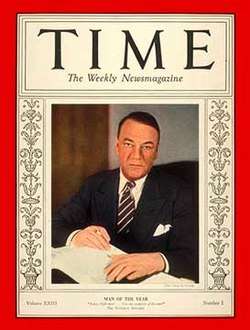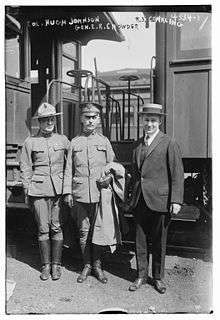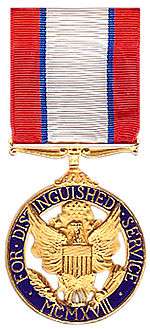Hugh S. Johnson
Hugh Samuel Johnson (August 5, 1882 – April 15, 1942) was a U.S. Army officer, businessman, speech writer, government official and newspaper columnist. He is best known as a member of the Brain Trust of Franklin D. Roosevelt in 1932–34. He wrote numerous speeches for FDR and helped plan the New Deal. Appointed head of the National Recovery Administration (NRA) in 1933, he was highly energetic in his "blue eagle" campaign to reorganize American business to reduce competition and raise wages and prices. Schlesinger (1958) and Ohl (1985) conclude that he was an excellent organizer, but that he was also domineering, abusive, outspoken, and unable to work harmoniously with his peers. The NRA was terminated by a 1935 ruling of the Supreme Court, and Johnson left the administration after a little more than a year.[2]
Hugh S. Johnson | |
|---|---|
 Hugh S. Johnson on the cover of Time | |
| Birth name | Hugh Samuel Johnson |
| Nickname(s) | Iron Pants |
| Born | August 5, 1882 Fort Scott, Kansas, U.S. |
| Died | April 15, 1942 (aged 59)[1] Washington, D.C., U.S. |
| Allegiance | United States |
| Service/ | United States Army |
| Years of service | 1903–1919 |
| Rank | Brigadier general |

Early life

He was born in Fort Scott, Kansas in 1882[3] to Samuel L. and Elizabeth (née Mead) Johnson.[4]
His paternal grandparents, Samuel and Matilda (MacAlan) Johnson, emigrated to the United States from Ireland in 1837 and originally settled in Brooklyn, New York.[4] Hugh's father was a lawyer, and he attended public school in Wichita, Kansas, before the family moved to Alva, Oklahoma Territory.[4] He attempted to run away from home to join the Oklahoma state militia at the age of 15, but he was apprehended by his family before he left town.[5] His father promised to try to secure him an appointment to the United States Military Academy (West Point), and was successful in obtaining an alternate appointment.[6][3][5] Johnson himself discovered that the individual who was first in line for the appointment was too old, and convinced him to step aside so that Johnson could enter the Academy.[5]
Military career
Johnson entered West Point in 1899,[6][3][7] and graduated and was commissioned a second lieutenant in the 1st Cavalry on June 11, 1903.[6][7] Douglas MacArthur was one of his West Point classmates.[3] From 1907 to 1909 he was stationed at Pampanga, Philippines, but later was transferred to California.[6][7] In the early years of the 20th century, most national parks in the United States were administered by units of the United States Army.[8] Johnson was subsequently stationed at Yosemite and Sequoia national parks.[6] He was promoted to first lieutenant on March 11, 1911, and was named superintendent of Sequoia National Park in 1912.[6]
Wishing to follow in his father's footsteps, Johnson won permission from General Enoch Crowder[5] to attend the University of California (at Berkeley) where he received his Bachelor of Arts degree (with honors) in 1915 and his Juris Doctor in 1916 (doubling up on courses to graduate in half the time required).[6][5] Transferring to the Judge Advocate General's Corps (JAG), from May to October 1916 he served under General John J. Pershing in Mexico with the Pancho Villa Expedition.[6] promoted to captain on July 1, 1916, he transferred to the JAG headquarters in Washington, D.C., in October 1916.[6][7] He was promoted to major on May 15, 1917, and to lieutenant colonel on August 5, 1917.[6][7] He was named Deputy Provost Marshal General in October 1917,[6][9] and the same month was named to a Department of War committee on military training (the U.S. had entered World War I on April 6, 1917).[6][10]
As a captain, Johnson helped co-author the regulations implementing the Selective Service Act of 1917.[3] Without Congressional authorization, he ordered completed several of the initial first steps needed to implement the draft.[5] The action could have led to his court-martial had Congress not acted (a month later) to pass the conscription law.[5] He was promoted to colonel on January 8, 1918, and to brigadier general on April 15, 1918.[6][7][11] At the time of his promotion, he was the youngest person, at the age of 35, to reach the rank of brigadier general since the Civil War, and the youngest West Point graduate to remain continuously in the service who had ever reached the rank.[5] Ohl (1985) finds that Johnson was an excellent second-in-command during the war in the Office of the Provost Marshal under Brigadier General Enoch H. Crowder as long as he was closely watched and tightly supervised. His considerable talents were effectively drawn upon in the planning and implementation of the registration and draft before and during the conflict. However he was never able to work smoothly with others.[12]
Upon his promotion to brigadier general, Johnson was appointed director of the Purchase and Supply Branch of the General Staff in April 1918,[6][5] and was promoted to Assistant Director of the Purchase, Storage and Traffic Division of the General Staff in October 1918.[6] In this capacity, he worked closely with the War Industries Board.[3] He favorably impressed many businessmen, including Bernard Baruch (head of the War Industries Board).[3] These contacts later proved critical in winning Johnson a position with President Franklin D. Roosevelt's administration.[3] He was put in command of the 15th Infantry Brigade which was part of the 8th Division, but the unit did not deploy to Europe because the war had ended. [13]
Johnson resigned from the U.S. Army on February 25, 1919.[13] For his service in the Provost Marshal's office and in executing the draft, he was awarded the Army Distinguished Service Medal in 1926.[13]
New Deal career
Johnson was named assistant general manager of the Moline Plow Company on September 1, 1919.[13] Moline Plow's president, George Peek, and Johnson were both supporters of the McNary–Haugen Farm Relief Bill, a proposed federal law which would have established the first farm price supports in U.S. history.[3]
Johnson left Moline Plow in 1927 to become an adviser to Bernard Baruch.[14] He joined the Brain Trust of Franklin D. Roosevelt in the 1932 presidential election. His major role was drafting speeches, most notably one that FDR delivered in Pittsburgh denouncing the reckless spending of the Hoover administration and calling for a very conservative fiscal policy.[15]
NRA
Johnson played a major role in the New Deal. In 1933 Roosevelt appointed Johnson to administer the National Recovery Administration (NRA).
Some claim Johnson looked on Italian Fascist corporativism as a kind of model.[16][17] He distributed copies of a fascist tract called "The Corporate State" by one of Mussolini's favorite economists, Bruno Biagi, including giving one to Labor Secretary Frances Perkins and asking her give copies to her cabinet.[18] The NRA involved organizing thousands of businesses under codes drawn up by trade associations and industries. He was recognized for his efforts when Time named him Man of the Year of 1933—choosing him instead of FDR.[19]
He was faltering badly by 1934, which historians ascribe to the profound contradictions in NRA policies, compounded by heavy drinking on the job. The NRA continued to deteriorate—it was abolished in 1935—and he came under attack by Labor Secretary Frances Perkins for having Fascist inclinations. Therefore, Roosevelt fired Johnson in September 1934 [20]
Sarah Lucille Turner, who had been one of the first women elected to the Missouri House of Representatives, worked with Johnson for a time while he was administrator of the NRA. [21]
Journalism, later life and death
Upon leaving the Roosevelt administration, Johnson, who had long been a successful essay writer for national magazines, now became a syndicated newspaper columnist specializing in political commentary. He supported Roosevelt in the 1936 presidential election, but when the Court-packing plan was announced in 1937 he denounced Roosevelt as a would-be dictator. In 1939 he endorsed isolationism—staying out of World War II; he endorsed Wendell Willkie the Republican candidate in the 1940 presidential election.[12]
Johnson wrote a number of articles and stories. One future history piece, The Dam, was written in 1911 and appears in the Sam Moskowitz anthology, Science Fiction by Gaslight. In the story, Japan invades and conquers California.
General Hugh S. Johnson died in Washington, D.C., in April 1942 from pneumonia.[1] He was buried in Arlington National Cemetery.
Awards
Dates of rank
| No insignia | Cadet, United States Military Academy: June 13, 1899 |
| No insignia in 1903 | Second Lieutenant, Regular Army: June 11, 1903 |
| First Lieutenant, Regular Army: March 11, 1911 | |
| Captain, Regular Army: July 1, 1916 | |
| Major, Regular Army: May 15, 1917 | |
| Lieutenant Colonel, National Army: August 5, 1917 | |
| Colonel, National Army: January 8, 1918 | |
| Brigadier General, National Army: April 15, 1918 |
Footnotes
- "Hugh S. Johnson Dies in Capital," New York Times, April 16, 1942.
- Schlesinger (1958) pp 105–6; Ohl (1985)
- Hamby, For the Survival of Democracy: Franklin Roosevelt and the World Crisis of the 1930s, 2004, p. 144.
- White, The National Cyclopaedia of American Biography, 1967, p. 5.
- Crawford, "He Risked Disgrace to Speed the Draft," New York Times, June 9, 1918.
- Cullum, Biographical Register of the Officers and Graduates..., 1920, p. 1044.
- Howard, "Our Twenty-one Generals of Forty Years and Under," New York Times, August 24, 1919.
- See, generally: Hampton, How the U.S. Cavalry Saved Our National Parks, 1971.
- "Col. H. S. Johnson Deputy Provost Marshal," New York Times, January 25, 1918.
- "Plans to Mobilize Schools to Aid War," New York Times, February 17, 1918.
- "Promotes 10 Brigadiers," New York Times, April 17, 1918.
- Ohl (1985)
- Cullum, Biographical Register of the Officers and Graduates..., 1920, p. 1045.
- Davis, Jr., Henry Blaine (1998). Generals in Khaki. Pentland Press, Inc. p. 204. ISBN 1571970886. OCLC 40298151
- Frank Freidel, Franklin D. Roosevelt: The Triumph (1956) 361-63
- Stanley G. Payne, A History of Fascism, 1914–1945, 1996, p. 230.
- Whitman, James Q. (1991). "Of Corporatism, Fascism, and the First New Deal". The American Journal of Comparative Law. 39 (4): 747. Retrieved 31 March 2020.
- Martin, Madam Secretary: Frances Perkins, 1976, p. 335.
- see TIME story
- Martin, Madam Secretary: Frances Perkins, 1976, p. 337.
- Lawrence O. Christensen; William E. Foley; Gary Kremer (October 1999). Dictionary of Missouri Biography. University of Missouri Press. ISBN 978-0-8262-6016-1.
References
- Cullum, George Washington. Biographical Register of the Officers and Graduates of the U.S. Military Academy at West Point, N.Y.: From Its Establishment, in 1802, to 1890. 3d ed. New York: Houghton, Mifflin, 1920.
- Hampton, H. Duane. How the U.S. Cavalry Saved Our National Parks. Bloomington, Ind.: Indiana University Press, 1971. ISBN 0-253-13885-X
- Hamby, Alonzo L. For the Survival of Democracy: Franklin Roosevelt and the World Crisis of the 1930s. New York: Simon and Schuster, 2004. ISBN 0-684-84340-4
- Hawley, Ellis W. The New Deal and the Problem of Monopoly: A Study in Economic Ambivalence (1966) on NRA
- Ohl, John Kennedy. Hugh S. Johnson and the New Deal. DeKalb, Ill.: Northern Illinois Univ Press, 1985. ISBN 0-87580-110-2, standard scholarly biography
- Ohl, John Kennedy. "Tales Told by a New Dealer: General Hugh S. Johnson," Montana: The Magazine Of Western History 1975 25(4): 66–77
- Schlesinger, Arthur, Jr. The Coming of the New Deal (1958), extensive coverage of Johnson's NRA
- White, James Terry. The National Cyclopaedia of American Biography. Ann Arbor, Mich.: University Microfilms, 1967.
Primary sources
- Johnson, Hugh S. The Blue Eagle From Egg to Earth. New York: Doubleday, Doran & Company, 1935.
- Crawford, William H. "He Risked Disgrace to Speed the Draft." New York Times. June 9, 1918.
- Howard, C.B. "Our Twenty-one Generals of Forty Years and Under." New York Times. August 24, 1919.
- "Col. H. S. Johnson Deputy Provost Marshal." New York Times. January 25, 1918.
- "Hugh S. Johnson Dies in Capital." New York Times. April 16, 1942.
- "Not Since the Armistice..." Time. September 25, 1933.
- "Plans to Mobilize Schools to Aid War." New York Times. February 17, 1918.
- "Promotes 10 Brigadiers." New York Times. April 17, 1918.